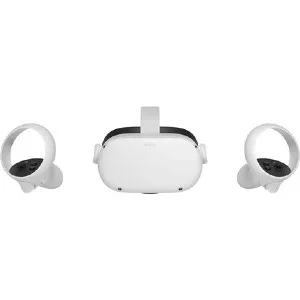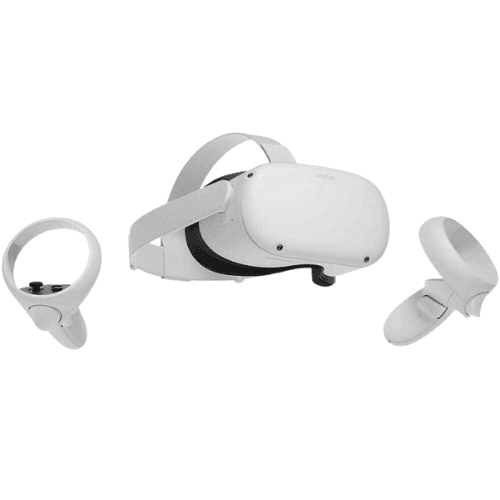The Oculus Quest 2 looks like something Apple would have designed around the turn of the century. In this case, the use of white rounded plastic and minimal interface is very sincere flattery that looks rather good, both in-hand and when it’s strapped to your face.
OK, maybe not that good — it’s still hard to look dignified with a VR headset on, and that’s not going to change any time soon — but at least the design and fit are built with comfort and utility in mind. While not everyone will want to engage with the Oculus Quest 2 for extended periods of time, if you do, it’s entirely feasible to engage that way.
The headset is minimalistic, with a power button on the right side and USB-C — for charging and tethering to a PC — and headphone jacks on the left. Oculus has tweaked the way you fit the Oculus Quest 2 to your face relative to the original model, with sliding lenses that are a lot easier to fit and get to the correct focal depth even if you wear glasses.
However, you’ll still likely want somebody else nearby to fit the head strap comfortably, since trying to fit a strap to your head while you’re wearing it is a tricky undertaking.
The Oculus Quest 2 uses a slightly reworked set of hand controls relative to the original model, although both still rely on simple handgrips with top-facing loops that the headset uses to track the position and movement of each handgrip. Each grip has an analogue stick and two primary action buttons as well as two analogue triggers and dedicated oculus and menu option buttons.
You can actually do without the hand controls if you like because the Oculus Quest 2 is capable of tracking your actual hands — at least in theory. Hand-tracking within the Oculus menus works and is kind of cool when you first start using it.
But the problem is that very few apps are compatible, forcing you back to the handgrips for most games, interactive VR experiences or streaming media binge sessions. It’s neat technology, and you’ll gush with appreciation the first time you see your fingers in VR space, but that’s about all you’ll be able to do for now.
Performance
Performance
- Involves data sharing with Facebook
- Guardian does a good job of protecting you (except against cats)
- Wide library of VR experiences
- Fast motion can still topple some users
- PC link gives the Quest 2 lots of future-proofing
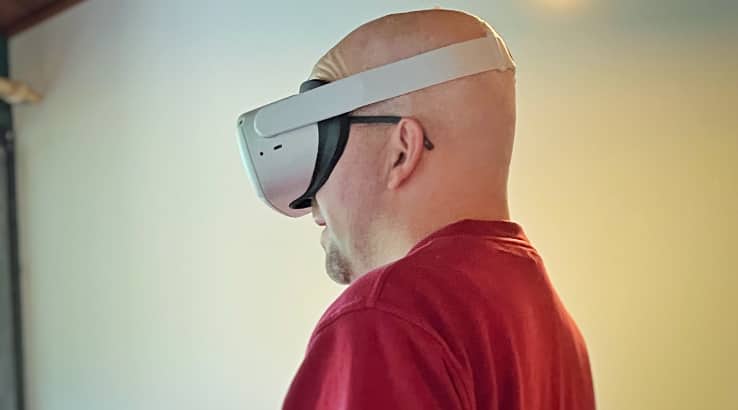
Setting up the Oculus Quest 2 involves connecting an Oculus — if you’re a prior Oculus owner — or Facebook account to link it to. You’ll also need to charge the primary headset and drop a single AA battery into each handgrip.
From there, you’re guided, mostly visually, through organizing your play space. Oculus hasn’t changed much here for the Quest 2, but then it didn’t really need to. You still draw out a virtual “guardian” space, using the Quest 2’s external cameras to look around your room and define a safe movement parameters.
As soon as you step close to your specified boundaries, the real room view intrudes on your VR activity, keeping you from tripping over furniture or bumping into the walls. The one note of caution here is that the Quest 2 is in no way pet-aware — which means I discovered the hard way that it’s possible to trip over your cat while using the Oculus Quest 2. Neither headset nor pussycat was harmed at that time, although my pride did take a bruising.
One note to consider with the Oculus Quest 2 is that it’s a company wholly owned by Facebook. Set up the Oculus Quest 2 with an Oculus account if you already have an Oculus device. If you don’t, you must use Facebook, and Facebook is in the process of handing all Oculus accounts over for Facebook control by 2023.
However, if you don’t use Facebook for privacy or security reasons — or if you simply don’t like Facebook — then you’re rather stuck if you want to use the Oculus Quest 2 at all. Using it involves accepting that your usage is going to end up being logged, recorded and used for data matching by Facebook at some point.
The entire point of the Oculus Quest 2 is it’s a standalone device — you don’t need to set up any further tracking cameras or necessarily hook up to an external computing device or console to experience the wider world of VR.
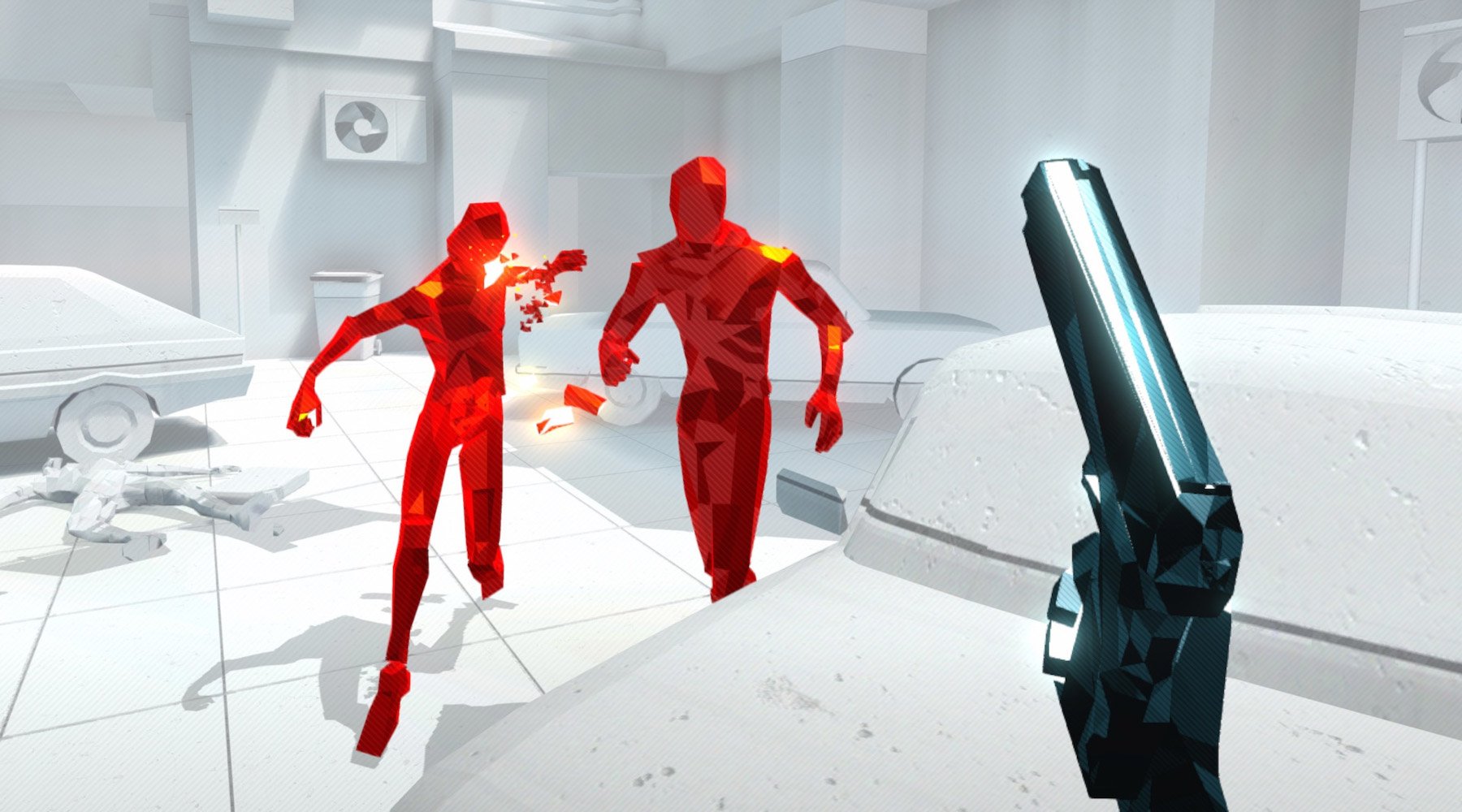
Superhot VR (Image: Supplied)
Since it’s an update to an existing model — and because Oculus now has many years of VR experience — there’s a wide range of VR experiences available through the Oculus shop to enjoy, both paid and free. Some of the classics remain classics and work well on the Oculus Quest 2, with titles such as Beat Saber and SuperHot VR remaining must-play titles, but there’s also a good quantity of apps that aim to inform as much as entertain through the VR medium.
You can even use the Oculus Quest 2 for your Netflix binges, with a full client app that creates a “virtual” home cinema for you to sit and watch whatever you wish on Netflix. It’s a little odd sitting down to binge-watch Brooklyn Nine-Nine and looking down to discover you don’t have legs, but it’s also a nice way to enjoy a huge screen experience without needing a large wall to hang an expensive TV set onto. The one catch here is that you’re well advised to plug in a set of headphones when watching any video content, or even most games, unless everyone else in your house also wants to hear what you’re doing.
If you’re the sharing type, the Oculus Quest 2 is fully Chromecast-compatible, so you can show what you’re looking at to any nearby cast-compatible display.
I tested this out with a Shield TV and beyond some early onset graphics streaming issues, it worked quite well for family gaming, although less well for any kind of video. That’s mostly because the casted image tracks relative to the motion of the head unit, which means that it’ll naturally wobble a lot depending on the wearer’s own head motions. You don’t really notice that when you’re wearing it, but it’s rather disconcerting for anyone watching the casted version of your VR session.
The classic issue for VR headsets is motion sickness, and here the Oculus Quest 2 gets a qualified pass.
I’m someone who often finds VR and virtual 3D experiences like movies to seriously upset my sense of balance quickly. But for the most part, once I had the focus right, most VR experiences worked well.
The exception here is any fast motion experience, where it’s still entirely possible to feel like you’re going to lose your lunch rapidly. In other words, approach those VR rollercoasters with caution — and maybe with a paper bag nearby.
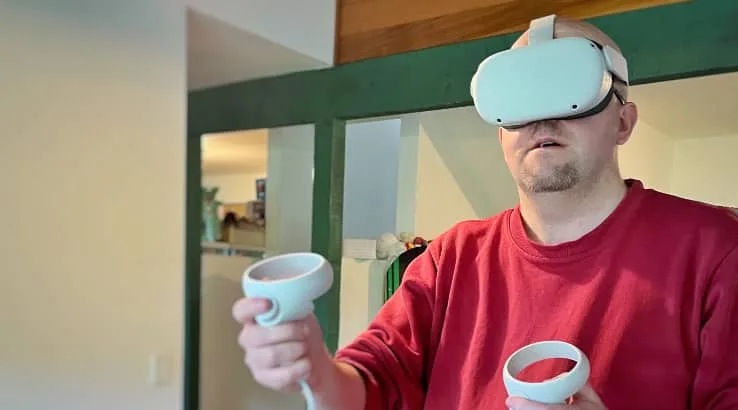
Where the original Quest was essentially the lower-cost “partner” device to the Oculus Rift, the Oculus Quest 2 is pretty much the stated future of the Oculus platform and that means that it’s not limited to only working as a standalone headset.
You can also use it tethered to a PC for VR-suitable titles through platforms such as Steam VR. That does involve using a tethered USB-C cable — Oculus has an official five-metre cable that allows for a decent range of motion, but in theory, any USB-C 2.0 cable should work — and some set up on the PC side, including checking if your rig is actually capable of running VR at a satisfactory rate. If you’re keen on VR, you’ve probably already checked that kind of detail, and if not, Steam’s VR Performance Test app is a good place to start.
That tethering can be something of a pain, but it does nicely sidestep the one issue for the Oculus Quest 2’s ongoing value, and that’s performance. The Oculus Quest 2 is built on a custom Qualcomm Snapdragon XR2 chip, quite a bit more powerful than the original Quest, but that’s going to look pokier over time. Being able to tether to a PC opens up the wider world of VR experiences to the Oculus Quest 2, and you’re only limited by the rendering power of your computer and the Oculus Quest 2’s 1920×1832 pixel internal display.
Battery life
Battery life
- Two to three hour battery life is a bit of a bummer
- Why don't the handgrips use rechargeable batteries?
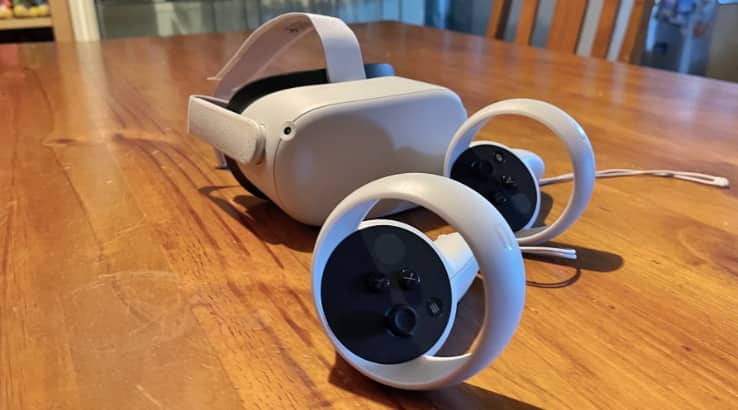
Amid all this fun, you’ll have to stop every once in a while to recharge the Oculus Quest 2. Oculus claims that it’s good for between two and three hours of runtime between recharges, but that largely depends on your precise VR use. I found that if I was watching a video that longer runtime might be feasible, but more intense games tended to sap the battery a lot faster.
It’s not just the headset you have to concern yourself with here either. The two handgrips need power, and confusingly, Oculus has opted to use AA batteries to keep them powered up.
Given you’ve got to plug in the headset more regularly to keep it topped up, having sealed rechargeables for the handgrips would have been preferable. As it is, the best way to manage this for your wallet and the environment would be using rechargeable AA batteries instead.
Should you buy the Oculus Quest 2?
- Improved resolution over original Quest
- PC link adds a lot of future proofing
- Comfortable fit
- Guardian app can’t protect you from everything
- Limited battery life
- Mandatory Facebook account
In terms if technology, the Oculus Quest 2 is a big and welcome jump over the Oculus Quest. That’s why it sits comfortably as our pick for the best standalone VR headset. It takes the standalone appeal of that headset, adds in welcome PC compatibility, processor upgrades and display improvements, making it an easy recommendation for those wanting to dip their toes into the VR waters without the investment immediately in a VR-ready PC.
That being said, it’s not perfect. The need for a Facebook account for new Oculus users will be a deal-breaker for many, and the short battery life makes it a device that you can’t dedicate entire evenings to enjoying easily.
Also, stay away from those VR rollercoasters. Learn from my mistakes.
Pricing and availability
Specifications
Connectivity
Whether products shown are available to you is subject to individual provider sole approval and discretion in accordance with the eligibility criteria and T&Cs on the provider website.
Are you visiting from outside the US?
Ask a question
More guides on Finder
-
10 best VR headsets
Learn what you need to look for when choosing your first VR headset.
-
8 best metaverse games
8 best decentralized metaverse games to earn and play.
-
Valve Index review: Wrapping your fingers around VR
The Valve Index competes in the premium virtual reality market, but is finger tracking enough to make this VR headset worth it?
-
HTC Vive Focus 3 review: The best business VR headset?
The HTC Vive Focus 3 looks to deliver a premium grade, wireless virtual reality headset with backend features suited for businesses. Is it any good?
-
HTC Vive Pro 2 review: Is it worth the upgrade?
While the HTC Vive Pro 2 offers the best VR experience in the market, it’s held back by a reliance on old technology.
-
Upland vs. Decentraland
Two very unique metaverses with different objectives: Upland vs. Decentraland.
-
HTC Vive Cosmos and HTC Vive Cosmos Elite review
More than two years after release, do the HTC Vive Cosmos and the HTC Vive Cosmos Elite still have a place in the VR headset market?

